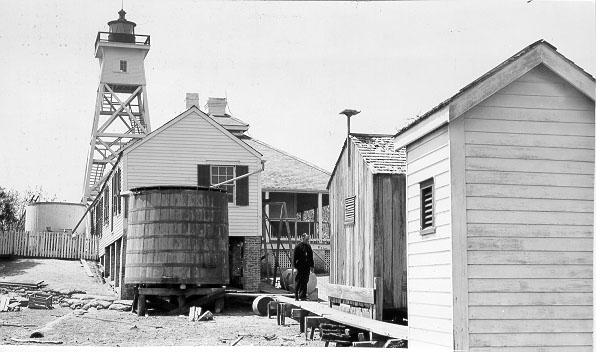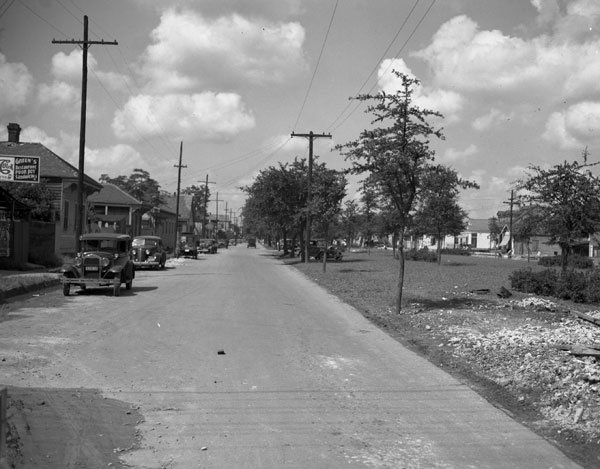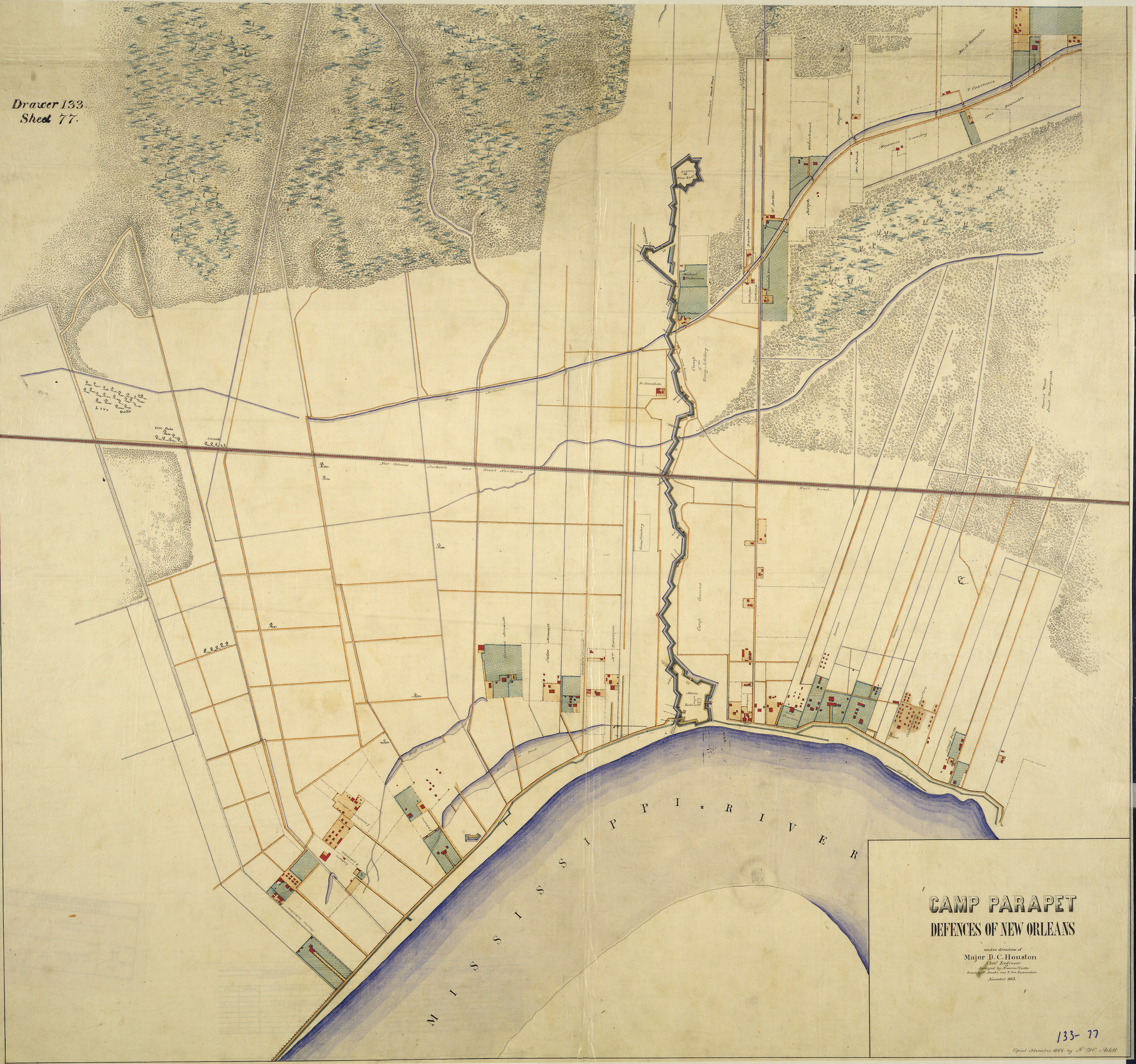|
Shrewsbury, Louisiana
Shrewsbury is an unincorporated town in Jefferson Parish, Louisiana, along the Mississippi River and Shrewsbury Road about 1 mile upriver from the border of the city of New Orleans. The name came into use in the mid-19th century, and became less commonly used towards the end of the 20th century, when surrounding communities of unincorporated Jefferson grew together as a suburb of New Orleans. The area is now generally known as Old Jefferson and is part of the Greater New Orleans Metropolitan area. During the early 20th century, Shrewsbury Road was an official link in the Jefferson Highway (State Route 1, and later U.S. Route 61) and provided the main automobile route into New Orleans via Metairie Road. It faded in importance as new and more direct routes into the city were constructed, namely the extensions of Jefferson Highway (1928) and Airline Highway (1940) into South Claiborne Avenue and Tulane Avenue, respectively. The final blow came in June 1957 when the railroad cr ... [...More Info...] [...Related Items...] OR: [Wikipedia] [Google] [Baidu] |
Jefferson Parish, Louisiana
Jefferson Parish (french: Paroisse de Jefferson; es, Parroquia de Jefferson) is a parish in the U.S. state of Louisiana. As of the 2020 census, the population was 440,781. Its parish seat is Gretna, its largest community is Metairie, and its largest incorporated city is Kenner. Jefferson Parish is included in the Greater New Orleans area. History 1825 to 1940 Jefferson Parish was named in honor of U.S. President Thomas Jefferson of Virginia when the parish was established by the Louisiana Legislature on February 11, 1825, a year before Jefferson died. A bronze statue of Jefferson stands at the entrance of the General Government Complex on Derbigny Street in Gretna. The parish seat was in the city of Lafayette, until that area was annexed by New Orleans in 1852. In that year the parish government moved to Carrollton, where it remained for twenty-two years. Originally, this parish was larger than it is today, running from Felicity Street in New Orleans to the St. Charles P ... [...More Info...] [...Related Items...] OR: [Wikipedia] [Google] [Baidu] |
Mississippi River
The Mississippi River is the second-longest river and chief river of the second-largest drainage system in North America, second only to the Hudson Bay drainage system. From its traditional source of Lake Itasca in northern Minnesota, it flows generally south for to the Mississippi River Delta in the Gulf of Mexico. With its many tributaries, the Mississippi's watershed drains all or parts of 32 U.S. states and two Canadian provinces between the Rocky and Appalachian mountains. The main stem is entirely within the United States; the total drainage basin is , of which only about one percent is in Canada. The Mississippi ranks as the thirteenth-largest river by discharge in the world. The river either borders or passes through the states of Minnesota, Wisconsin, Iowa, Illinois, Missouri, Kentucky, Tennessee, Arkansas, Mississippi, and Louisiana. Native Americans have lived along the Mississippi River and its tributaries for thousands of years. Most were hunter-ga ... [...More Info...] [...Related Items...] OR: [Wikipedia] [Google] [Baidu] |
New Orleans
New Orleans ( , ,New Orleans Merriam-Webster. ; french: La Nouvelle-Orléans , es, Nueva Orleans) is a Consolidated city-county, consolidated city-parish located along the Mississippi River in the southeastern region of the U.S. state of Louisiana. With a population of 383,997 according to the 2020 U.S. census, it is the List of municipalities in Louisiana, most populous city in Louisiana and the twelfth-most populous city in the southeastern United States. Serving as a List of ports in the United States, major port, New Orleans is considered an economic and commercial hub for the broader Gulf Coast of the United States, Gulf Coast region of the United States. New Orleans is world-renowned for its Music of New Orleans, distinctive music, Louisiana Creole cuisine, Creole cuisine, New Orleans English, uniq ... [...More Info...] [...Related Items...] OR: [Wikipedia] [Google] [Baidu] |
Suburb
A suburb (more broadly suburban area) is an area within a metropolitan area, which may include commercial and mixed-use, that is primarily a residential area. A suburb can exist either as part of a larger city/urban area or as a separate political entity. The name describes an area which is not as densely populated as an inner city, yet more densely populated than a rural area in the countryside. In many metropolitan areas, suburbs exist as separate residential communities within commuting distance of a city (cf "bedroom suburb".) Suburbs can have their own political or legal jurisdiction, especially in the United States, but this is not always the case, especially in the United Kingdom, where most suburbs are located within the administrative boundaries of cities. In most English-speaking countries, suburban areas are defined in contrast to central or inner city areas, but in Australian English and South African English, ''suburb'' has become largely synonymous with what ... [...More Info...] [...Related Items...] OR: [Wikipedia] [Google] [Baidu] |
Jefferson, Louisiana
Jefferson is a census-designated place (CDP) in Jefferson Parish, Louisiana, United States, on the north side (referred to as the "East Bank") of the Mississippi River. Jefferson is part of the New Orleans– Metairie–Kenner metropolitan statistical area. The population was 11,193 at the 2010 census, and 10,533 in 2020. It is often known by locals as "Old Jefferson" (to distinguish itself from the rest of Jefferson Parish), but should not be confused with Old Jefferson in East Baton Rouge Parish, Louisiana. History Early French colonial documents show what would become Jefferson as part of the "Tchoupitoulas Coast" of Native American settlement. In the French and Spanish colonial era it was divided into a series of plantations with boundary lines perpendicular to the Mississippi River. In the American Civil War, Camp Parapet was built originally by Confederate forces to defend New Orleans from an attack from the upriver side. After the Union liberated the city sailin ... [...More Info...] [...Related Items...] OR: [Wikipedia] [Google] [Baidu] |
Greater New Orleans
The New Orleans metropolitan area, designated the New Orleans–Metairie metropolitan statistical area by the U.S. Office of Management and Budget, or simply Greater New Orleans (french: Grande Nouvelle-Orléans, es, Gran Nueva Orleans), is a metropolitan statistical area designated by the United States Census Bureau encompassing eight Louisiana parishes—the equivalent of counties in other U.S. states—centered on the city of New Orleans. The population of Greater New Orleans was 1,271,845 in 2020, up from 1,189,166 at the 2010 United States census. According to 2017 census estimates, the broader New Orleans–Metairie–Hammond combined statistical area (CSA) had a population of 1,510,562. The New Orleans metropolitan area was hit by Hurricane Katrina—once a category 5 hurricane, but a category 3 storm at landfall—on August 29, 2005. Within the city of New Orleans proper, multiple breaches and structural failures occurred in the system of levees and flood walls designed ... [...More Info...] [...Related Items...] OR: [Wikipedia] [Google] [Baidu] |
Metropolitan Area
A metropolitan area or metro is a region that consists of a densely populated urban agglomeration and its surrounding territories sharing industries, commercial areas, transport network, infrastructures and housing. A metro area usually comprises multiple principal cities, jurisdictions and municipalities: neighborhoods, townships, boroughs, cities, towns, exurbs, suburbs, counties, districts, as well as even states and nations like the eurodistricts. As social, economic and political institutions have changed, metropolitan areas have become key economic and political regions. Metropolitan areas typically include satellite cities, towns and intervening rural areas that are socioeconomically tied to the principal cities or urban core, often measured by commuting patterns. Metropolitan areas are sometimes anchored by one central city such as the Paris metropolitan area (Paris) or Mumbai Metropolitan Region (Mumbai). In other cases metropolitan areas contain multiple centers ... [...More Info...] [...Related Items...] OR: [Wikipedia] [Google] [Baidu] |
Jefferson Highway
The Jefferson Highway was an automobile highway stretching through the central United States from New Orleans, Louisiana, to Winnipeg, Manitoba, Canada. The Jefferson Highway was replaced with the new numbered US Highway system in the late 1920s. Portions of the highway are still named Jefferson Highway, for example: the portions that run through Jefferson Parish, Louisiana; East Baton Rouge Parish, Louisiana; Lee's Summit, Missouri; Osseo, Minnesota; and Wadena, Minnesota. It was built in the 1910s as part of the National Auto Trail system. Named for President Thomas Jefferson, inspired by the east–west Lincoln Highway, it was nicknamed the "Palm to Pine Highway", for the varying types of trees found at either end. History The southern terminus of the Jefferson Highway was in New Orleans, Louisiana at the intersection of St. Charles Avenue and Common Street. It is marked by a six-foot tall Georgia granite obelisk donated by the New Orleans chapter of the Daughters ... [...More Info...] [...Related Items...] OR: [Wikipedia] [Google] [Baidu] |
Airline Highway
Airline Highway is a divided highway in the U.S. state of Louisiana, built in stages between 1925 and 1953 to bypass the older Jefferson Highway. It runs , carrying U.S. Highway 61 from New Orleans northwest to Baton Rouge and U.S. Highway 190 from Baton Rouge west over the Mississippi River on the Huey P. Long Bridge. US 190 continues west towards Opelousas on an extension built at roughly the same time. The highway was named "Airline" because it runs relatively straight on a new alignment, rather than alongside the winding Mississippi River. (Compare with the similar term ''air-line railroad''.) The name later became even more fitting, as both Louis Armstrong New Orleans International Airport and Baton Rouge Metropolitan Airport were built along the highway. Airline Highway also runs close to the site of the old Baton Rouge airfield (near the intersection of Airline and Florida Boulevard, now a park and government office complex), which brings it within blocks of the sim ... [...More Info...] [...Related Items...] OR: [Wikipedia] [Google] [Baidu] |
Claiborne Avenue
Claiborne Avenue is a major thoroughfare in New Orleans, Louisiana. It runs the length of the city, about , beginning at the Jefferson Parish line and ending at the St. Bernard Parish line; the street continues under different names in both directions. It is called ''South Claiborne Avenue'' upriver from Canal Street and ''North Claiborne Avenue'' from Canal to St. Bernard Parish. New Orleans' longest street was named in honor of William C. C. Claiborne, the first United States governor of Louisiana, serving during both the territorial period and as the first governor under statehood. New Orleans was the capital city in those days of the early 19th century. Route description Claiborne Avenue can be divided into three general sections as it winds through the city, following the curves of the Mississippi River. The Crescent For the first few miles in the city coming from Jefferson Parish, Claiborne Avenue is part of U.S. Highway 90; before crossing the parish line it is cal ... [...More Info...] [...Related Items...] OR: [Wikipedia] [Google] [Baidu] |
Camp Parapet
Camp Parapet was a Civil War fortification at Shrewsbury, Jefferson Parish, Louisiana, a bit more than a mile upriver from the current city limits of New Orleans. History The fortification consisted of a Confederate defensive line about a mile and 3/4 long stretching from the Mississippi River northward to Metairie Ridge. (The area farther north from the ridge to Lake Pontchartrain was at the time swampland.) This was intended to protect the city of New Orleans from Union attack from upriver. As the Union fleet took the city by sailing in from below, the fortification was never used. After the capture of New Orleans, U.S. forces garrisoned and expanded the fortifications to defend against a Confederate counter-attack, which never came. Under Union control, the Camp lay in the district of Brigadier General Thomas W. Sherman. In late-September 1862, Halbert E. Paine, captain of the 4th Wisconsin Infantry Regiment, assumed command of the camp. George H. Hanks, a lieutenant in the 1 ... [...More Info...] [...Related Items...] OR: [Wikipedia] [Google] [Baidu] |









